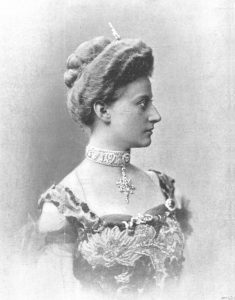Some royal scandals resound through history, cropping up like mushrooms whenever the subject of kingly misbehavior is raised—Henry VIII throwing over his wife and his church for the nubile charms of Anne Boleyn, Edward VIII renouncing his throne for an American divorcée with hip bones that could cut glass. Then there are the famous scandals that are not actually scandals at all—Catherine the Great did not, in fact, have intercourse with a horse—and some that really ought to be better known. Here are a few.

The Queen of Denmark and the Royal Physician
Poor Caroline Matilda! As a teenaged British princess, she was married off sight unseen to King Christian VII of Denmark—a perfectly nice young man except for his violent temper and fits of madness. In spite of Caroline Matilda’s warm charm and natural beauty, the royal marriage deteriorated swiftly along with the king’s mental state. His bouts of insanity were treated by a German doctor named Johann Struensee whose influence stabilized the monarch’s erratic behavior. The doctor believed that an improved relationship with his wife would also help the king, and he encouraged Christian to behave more kindly towards the queen. Isolated and unhappy in Denmark and at the mercy of a factional and gossipy court, Caroline Matilda was grateful for the doctor’s help and just as susceptible as her husband to Struensee’s calm authority. The physician and the queen became lovers, and together they worked to enact liberal reforms in the king’s name with Struensee eventually acquiring enough power to issue more than a thousand cabinet orders. Furious at the reforms, a conservative cabal plotted to overthrow the lovers in the king’s name. Struensee was executed, and Caroline Matilda was divorced from her husband and separated from her beloved children—one of whom was most likely Struensee’s. Thanks to the intervention of her brother, King George III of England, she was sent into exile in Germany rather than imprisoned in Denmark. In her genteel captivity, she amused herself with a tiny theatre, books, and charitable endeavors before dying suddenly of scarlet fever in 1775. She was 23.

The Tour de Nesle Affair
In 1314, King Philip IV of France was feeling rather good about his dynasty. His daughter, Isabelle, was Queen of England, and his three sons were neatly married off to a trio of noblewomen who were related to one another and ready to produce the next generation of French princes. Queen Isabelle, eager to welcome her sisters-in-law to the family, made them each a present of distinctive and costly embroidered purses. To Isabelle’s surprise, during the next family reunion, she spotted the purses hanging from the belts of a pair of brothers, knights at her father’s court at a time when prowess at arms made rock stars out of men who knew how to handle a lance. Wise to what this royal regifting meant, Isabelle hurried off to tell her father, and the king promptly set spies to watch his daughters-in-law. Within weeks, the trio of princesses were caught in flagrante with their lovers at a decrepit old Parisian fortress called the Tour de Nesle. The lovers were tortured in ways that would make any character on Game of Thrones shudder and finally executed—which must have come as a bit of a relief after all the castrating and flaying and oil-boiling. The princesses were imprisoned underground in dank, filthy dungeons, with their heads shaved and their children disinherited. The king himself died shortly afterwards. Within a generation, King Philip’s dynasty was destroyed, and the French throne passed to a distant cousin. The disagreement over who ought to inherit the crown sparked the Hundred Years’ War between England and France, plunging much of Western Europe into armed conflict that would last for the better part of a century, and all because of a trio of misbehaving princesses. In a delicious twist, it is said that the wreckage of King Philip’s dynasty is due to a curse laid upon him by Jacques de Molay, the Grand Master of the Templars, burned to death on bogus charges of heresy and witchcraft on the king’s orders earlier in 1314.

The Duke of Cumberland’s Midnight Intruder
Queen Victoria’s uncles were notorious for their exploits and excesses—drinking, gambling, seductions, and secret marriages—but none was as reviled as the Duke of Cumberland. In an age when character was supposedly mirrored by appearance, his sinister scar and violent temper marked him in public opinion as deeply malevolent. He was the least popular of King George III’s sons, and his reputation was not improved by the rumor that he had raped more than one noblewoman and impregnated his own sister, Princess Sophia. His infamy was sealed on a dark spring night in 1810. In the early hours, he suddenly leapt out of bed, screaming for his servants that he had been attacked, struck violently in the head several times. Claiming to be suspicious that his valet, Joseph Sellis, had not responded to his shouts, he dispatched his staff to search for the man. They found Sellis’s door bolted from the inside. After forcing the lock, they discovered Sellis, tucked in bed and nearly decapitated from a slash of a straight razor. Cumberland claimed—and an inquest agreed—that the valet committed suicide, but most people believed Sellis had been attacked by Cumberland. The public speculated about motives for the attack, each more sensational than the last and culminating in the explanation that Sellis was slashed after fighting off the duke’s attempt to rape him. True or not, it was a sordid story that followed Cumberland for the rest of his life, and there were fears upon Victoria’s accession to the throne that her uncle, heir presumptive until she bore her own child, would murder her to gain the crown. Part of the outpouring of jubilation at the birth of Queen Victoria’s eldest child was no doubt due to the fact that the villainous Cumberland was no longer first in the line of succession and had moved to Germany, never to return. (In 1830, another verdict of suicide was returned with another member of Cumberland’s household was found with a slashed throat. Nothing was ever proven against the duke, but it seems fair to suggest he was at the very least deeply unlucky.)

The Affair of the Poisons
Witchcraft! Poison! Sex! This scandal has it ALL. During the reign of Louis XIV, poison was having a heyday, providing a tidy path to inheritance and influence, but it came as a tremendous shock when the news broke that black magic rituals were being employed by those closest to the king himself. The scandal began with the arrest and execution of the Marquise de Brinvilliers, a noblewoman who murdered her father and brothers after trying out her poisons on the poor patients of the local charity hospital. The sensational story sparked rumors of other such crimes. A suspected forger and murderer claimed to have evidence that poison was rife at the court of the Sun King, and investigations were begun. It was discovered that the king’s chief mistress, the Marquise de Montespan, was implicated as a favored client of Catherine Monvoison, a Parisian supplier of powders and potions intended to secure the king’s affections. There were whispers of sex rituals and rites involving dead infants, news that horrified Louis. Monvoison—whose name, quite delightfully, means “my neighbor”—was burned at the stake and hundreds of others were implicated. Many died as a result of torture or suicide during the investigation, 36 were executed, and even those who escaped punishment were left with ruined reputations and lives in tatters. Madame de Montespan, who allegedly allowed a satanic priest to say a Black Mass over her naked body in a love rite to bind the Louis to her forever, was the mother of several of the king’s beloved illegitimate children and therefore too close to the monarch to be arrested and tried for her possible crimes. Instead, she quietly retired to a convent and a solemn life of contemplation and penance.

Princess Sophia Dorothea of Celle and the Case of the Missing Count
Beautiful and charismatic, Sophia Dorothea, daughter of the Duke of Brunswick-Lüneburg, was betrothed to her first cousin, George, a man so revolting his own subjects referred to him as “Pig Snout.” But George was potentially heir to two thrones, and the duke agreed to the match, gambling on winning a crown for his enchanting daughter. Unfortunately, Sophia Dorothea did not see the value in the arrangement and promptly fainted upon learning of the betrothal in 1682. The marriage went rapidly downhill from there, with frequent loud scenes and violent arguments—the last ending with George throttling Sophia Dorothea until servants intervened to save her life. Little wonder that when the dashing and handsome Count von Königsmarck arrived from Sweden, the bored and restless Sophia Dorothea found him irresistible. Upon first arriving at court, he had dallied briefly with George’s mistress, Countess Platen, but he soon had eyes only for the princess, embarking upon a torrid affair that was as indiscreet as it was passionate. Together, the lovers plotted to run away and make a new life for themselves far beyond the reach of her unlovely and vindictive husband. To Sophia Dorothea’s despair, the very night Königsmarck was supposed to carry her off, he failed to keep the assignation, disappearing from court entirely. Courtiers whispered that Countess Platen allegedly took her revenge by having the count attacked before he could elope with the princess, but she was never charged and no evidence was ever produced, least of all a corpse. But there were new floorboards hastily laid in the gallery outside Sophia Dorothea’s bedchamber, and no one ever saw Königsmarck again…Enraged by the scandal, George divorced Sophia Dorothea, separated her from her children, and had her imprisoned in a tiny castle on a lake. He went on to become King George I of England, leaving his scorned wife behind.

Princess Charlotte of Prussia’s Burn Book
Kaiser Wilhelm was problematic from birth. Militant, bombastic, and rude, this eldest grandson of Queen Victoria eventually plunged Europe into World War I simply because he liked playing military games—but his younger sister was not much better. Wayward, willful, and frequently malicious, Charly was often admonished to behave better in letters from her grandmother but to no avail, and there is good reason to believe that she may have been at the center of an outrageous scandal in the heart of her brother’s court. The German imperial court was lavish and snobby and given to extravagant debauchery. In the last decade of the nineteenth century, courtiers were terrorized for four years by accusatory notes detailing their misdeeds—some complete with pornographic sketches. Duels were fought, lives lost, and reputations shredded as a result of the letters that spilled all of the juicy details—everything from mate-swapping to full orgies. One male court official—Kotze—was arrested for sending the letters but released when authorities determined they were the work of a woman. Suspicion immediately fell upon Princess Charly. Some believed she had written the notes; others said her diary had been stolen and fallen into the wrong hands. There were even those who suggested Charly had hosted an evening of debauchery with the purpose of deliberately gathering blackmail material. In any event, the Kotze Affair remained a murky blot upon her reputation, the whispers following her until her death shortly after the first world war.

Marie Antoinette and the Dress That Shocked a Nation
The French queen’s most famous scandal is the affair of the diamond necklace, an outrageous fraud perpetrated by jewel thieves using her name, but a previous incident was perhaps even more damaging to the royal prestige. In 1783, Marie Antoinette was painted by the artist Élisabeth Vigée leBrun wearing a gaulle rather than formal court dress. A gaulle was a light, minimally structured gown of layers of cotton muslin with gently gathered sleeves, a rounded neck, and a wide, soft fabric sash—much more comfortable than the rigid, restrictive court attire—and suitable for the queen’s relaxed country pursuits at her private retreat on the grounds of Versailles. Unfortunately, the gaulle, for all its comfort and simplicity, resembled the chemise, a shift worn as an underlayer to protect expensive clothing from body odor and sweat. It might have been cool and practical and comfortable, but the choice of costume made it look like the Queen of France had been painted in her underwear. When the painting was displayed publicly, it was as deeply shocking to the French as if Queen Elizabeth II had been photographed in her Rigby and Peller corset. Not only was the queen shown stripped of the trappings of royalty, she was harshly criticized for not boosting the French luxury goods market by wearing costly domestic silks and trimmings. Cotton, associated with the slave trade and grown by the British in India and in the West Indies, was viewed as an English fabric, a deeply disloyal choice for a French queen. The uproar was immediate and deafening. The painting was swiftly taken down, but the damage had been done. Marie Antoinette was fair game for all manner of vicious attacks because she had permitted herself to be shown as human—and distinctly less than royal. The mystique of monarchy had been shattered once and for all, and within a decade, she would perish on the guillotine wearing another plain white cotton dress…Ironically, the gaulle became a fashionable garment for revolutionaries, signaling a rejection of the excesses of the nobility and a devotion to the principles of simplicity and authenticity.

















